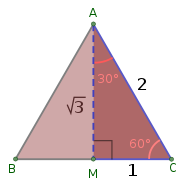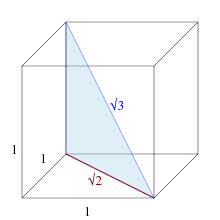Writing Root Three as a Continued Fraction
 The height of an equilateral triangle with sides of length 2 equals the square root of 3. | |
| Representations | |
|---|---|
| Decimal | 1.7320508075 68877 2935... |
| Continued fraction | |
| Binary | 1.10111011 0110 0111 1010 ... |
| Hexadecimal | 1.BB67AE85 84CA A73B ... |
The square root of 3 is the positive real number that, when multiplied by itself, gives the number 3. It is denoted mathematically as √3 or 31/2 . It is more precisely called the principal square root of 3, to distinguish it from the negative number with the same property. The square root of 3 is an irrational number. It is also known as Theodorus' constant, after Theodorus of Cyrene, who proved its irrationality.
As of December 2013, its numerical value in decimal notation had been computed to at least ten billion digits.[1] Its decimal expansion, written here to 65 decimal places, is given by OEIS: A002194:
- 1.7320508075 68877 29352 74463 41505 87236 69428 05253 81038 06280 55806
The fraction 97 / 56 ( 1.732142 857 ...) can be used as a good approximation. Despite having a denominator of only 56, it differs from the correct value by less than 1 / 10,000 (approximately 9.2×10−5 , with a relative error of 5×10−5 ). The rounded value of 1.732 is correct to within 0.01% of the actual value.
The fraction 716035 / 413403 ( 1.732050 807 56 ...) is accurate to 1×10−11 .
Archimedes reported a range for its value: ( 1351 / 780 ) 2
> 3 > ( 265 / 153 ) 2
.[2] The lower limit 1351 / 780 is an accurate approximation for √3 to 1 / 608400 (six decimal places, relative error 3×10−7 ) and the upper limit 265 / 153 to 2 / 23409 (four decimal places, relative error 1×10−5 ).
Expressions [edit]
It can be expressed as the continued fraction [1; 1, 2, 1, 2, 1, 2, 1, …] (sequence A040001 in the OEIS).
So it's true to say:
then when :
It can also be expressed by generalized continued fractions such as
which is [1; 1, 2, 1, 2, 1, 2, 1, …] evaluated at every second term.
Geometry and trigonometry [edit]


And, the height of a regular hexagon with sides of length 1.


The square root of 3 can be found as the leg length of an equilateral triangle that encompasses a circle with a diameter of 1.
If an equilateral triangle with sides of length 1 is cut into two equal halves, by bisecting an internal angle across to make a right angle with one side, the right angle triangle's hypotenuse is length one and the sides are of length 1 / 2 and √3 / 2 . From this the trigonometric function tangent of 60° equals √3 , and the sine of 60° and the cosine of 30° both equal √3 / 2 .
The square root of 3 also appears in algebraic expressions for various other trigonometric constants, including[3] the sines of 3°, 12°, 15°, 21°, 24°, 33°, 39°, 48°, 51°, 57°, 66°, 69°, 75°, 78°, 84°, and 87°.
It is the distance between parallel sides of a regular hexagon with sides of length 1.
It is the length of the space diagonal of a unit cube.
The vesica piscis has a major axis to minor axis ratio equal to 1:√3 , this can be shown by constructing two equilateral triangles within it.
Other uses [edit]
Power engineering [edit]
In power engineering, the voltage between two phases in a three-phase system equals √3 times the line to neutral voltage. This is because any two phases are 120° apart, and two points on a circle 120 degrees apart are separated by √3 times the radius (see geometry examples above).
See also [edit]
- Square root of 2
- Square root of 5
Notes [edit]
- ^ Łukasz Komsta. "Computations | Łukasz Komsta". komsta.net . Retrieved September 24, 2016.
- ^ Knorr, Wilbur R. (1976), "Archimedes and the measurement of the circle: a new interpretation", Archive for History of Exact Sciences, 15 (2): 115–140, doi:10.1007/bf00348496, JSTOR 41133444, MR 0497462, S2CID 120954547 .
- ^ Julian D. A. Wiseman Sin and Cos in Surds
References [edit]
External links [edit]
- Theodorus' Constant at MathWorld
- [1] Kevin Brown
- [2] E. B. Davis
Source: https://en.wikipedia.org/wiki/Square_root_of_3




![[2;-4,-4,-4,...]=2-{\cfrac {1}{4-{\cfrac {1}{4-{\cfrac {1}{4-\ddots }}}}}}](https://wikimedia.org/api/rest_v1/media/math/render/svg/3df57bb720cc504a437d49da6ab05bac2a3fb559)
0 Response to "Writing Root Three as a Continued Fraction"
Post a Comment